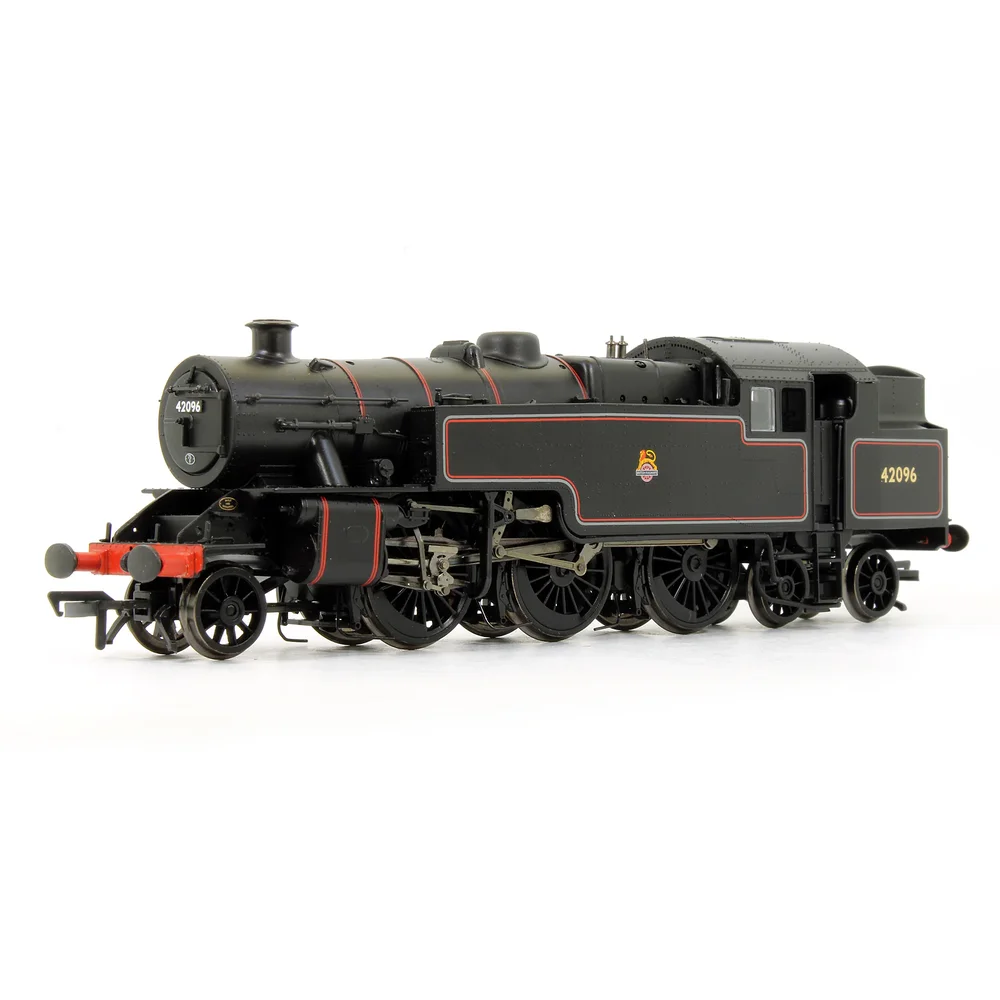Bachmann 32-876
London, Midland & Scottish Railway Fairburn 2-6-4T 42096 British Railways Lined Black with Early Emblem
Tooling
Bachmann introduced its OO gauge model of the LMS Fairburn 2-6-4T tank locomotive in the mid-2000s, with the first notable release appearing in 2006. This tooling represented a significant step forward in detail and performance compared to earlier steam models, offering accurate proportions and modern features for both collectors and operators. The prototype was designed by Charles Fairburn for the LMS in the 1940s and later adopted by British Railways, making it a popular subject for modelers of LMS and BR eras.
Tooling Features
- Scale: OO gauge (1:76), designed for LMS and BR liveries across Eras 3–5.
- Construction: Die-cast chassis for weight and traction, plastic bodyshell with fine rivet detail, separately fitted handrails and pipework.
- Detailing: Sprung buffers, turned brass safety valves, lamp irons, and vacuum pipes supplied in an accessory pack.
- Couplings: NEM pockets with tension-lock couplers fitted as standard.
Mechanical & Electrical
- Motor & Drive: Powerful 3-pole motor with all-wheel drive and pickup for smooth running.
- Minimum Radius: Recommended second radius (approx. 18 inches).
- Weighting: Die-cast chassis provides good adhesion and stability.
- Lighting: No factory-fitted lighting on this tooling.
DCC Capability
The model is DCC-ready with an 8-pin NEM652 socket located in the smokebox. A blanking plug is supplied for DC operation. Decoder installation requires removal of the body shell, which is secured by screws at the front and rear of the baseplate.
Liveries Produced
The initial releases included LMS black and a Collectors Club limited edition in Caledonian blue. Subsequent production runs featured BR lined black with early and late crests, plus weathered variants.
Reviews & Commentary
Upon release, the model was praised for its accurate proportions, robust mechanical performance, and ease of decoder installation compared to earlier Bachmann steam locomotives. Reviewers highlighted the fine detailing and smooth running qualities, making it a benchmark for mid-2000s OO gauge steam models.
Media & Social Media
Enthusiasts on forums and social platforms noted the model’s reliability and strong pulling power. While some commented that cab detail was basic compared to later standards, overall reception was positive, and the tooling remained popular until superseded by Bachmann’s later “Blue Riband” specification models.
Interesting Facts
- The Fairburn 2-6-4T was a key LMS design that influenced later BR Standard tank locomotives.
- Bachmann’s 2006 tooling included a comprehensive spares list, making maintenance straightforward for long-term owners.
Class & Prototype
- Class: London, Midland & Scottish Railway Fairburn 2-6-4T
- Traction: Steam
- Built: 1945-1951
- Total Built: 277
- Running Number: 42096
Operator & Livery
- Operator: British Railways
- Livery: Lined Black with Early Emblem
- Era: 4 - British Railways Early Emblem
British Railways transformed Britain's fragmented rail network into a unified national system following nationalisation on 1st January 1948. Created from the "Big Four" companies under the Transport Act 1947, BR operated most of Great Britain's railways until rebranding as British Rail in 1965, managing over 20,000 route miles and inheriting nearly 20,000 locomotives of diverse designs.
The organisation pioneered standardisation through its revolutionary BR Standard locomotive programme (1951-1960), producing 999 advanced steam engines under Robert Riddles' direction. These included the versatile Britannia Pacifics, mighty 9F freight engines, and mixed-traffic classes that incorporated the best features from all predecessor companies. The 1955 Modernisation Plan accelerated diesel and electric traction development, creating fascinating mixed-traction operations.
Notable achievements included establishing unified locomotive classification systems, introducing distinctive corporate liveries, and managing the complex transition from steam to modern traction. BR's six regional structure preserved operational diversity whilst enabling standardisation of practices, signalling, and rolling stock that had eluded private enterprise for over a century.
The BR era represents steam traction's final flowering alongside emerging diesel technology, creating unparalleled locomotive variety. Today, this heritage remains highly popular with railway enthusiasts through extensive preserved fleets, heritage railway operations, and comprehensive model ranges from manufacturers like Hornby, Bachmann, and Dapol, making BR subjects essential for authentic post-war British railway modelling across all scales.
British Railways' lined black livery was designated for mixed-traffic and secondary passenger locomotives from 1949, following pure LNWR style with black base colour and elaborate red, cream (off-white), and grey lining patterns. The lining specification comprised 5/8" grey, 1/8" cream, 1½" black, and ¼" red bands, with the layout consistent with LNWR practice including deep and shallow valances lined along bottom edges only, unlike green engines. The first lined black engines appeared in August 1948 when Hall 5954 appeared so painted, becoming one of the first to carry the "Lion and Wheel" emblem around the same time.
A wide range of engines was eligible for this livery, from powerful V2s and Counties down to tiny Southern Terriers, encompassing County, Hall, Grange, Manor, Saint, Prairie tanks, and numerous pre-grouping designs of varied shapes and sizes. This created many variations and interpretation problems due to the diverse locomotive types involved, with regional differences in splasher lining treatment—the Eastern Region used red-only splasher lining, whilst the Southern Region evolved from inset to edge lining styles. The emblem was positioned centrally on tender sides above the middle axle box, with the Western Region favouring larger sizes on tenders and bigger tank engines. An interesting period detail saw number plates routinely painted red from late 1949 to early 1952, adding colour contrast to the otherwise black scheme. This livery represented BR's commitment to standardising mixed-traffic operations whilst maintaining the decorative traditions that distinguished passenger-rated locomotives from plain freight engines.
